Monomorium exiguum Forel
 Type location Ethiopia
(Monomorium exiguum n. spec.,
Forel, 1894b: 85, worker) south Abyssinia, Ilg - see below Type location Ethiopia
(Monomorium exiguum n. spec.,
Forel, 1894b: 85, worker) south Abyssinia, Ilg - see below
junior synonyms
bulawayensis
(Monomorium (Mitara) exiguum
For. v. bulawayensis n.v.,
Forel, 1913j: 217, worker) from Zimbabwe - see below
faurei (Monomorium
(Mitara) Faurei n. sp., Santschi, 1915c: 260, illustrated,
worker) from Gabon, collected at Samkita by
Faure - see http://www.antweb.org/specimenImages.do?name=casent0010878
flavescens (Monomorium
(Mitara) exiguum For. r. flavescens
n. stirps, Forel, 1916: 418,
worker) from Zaïre, collected at St. Gabriel, by Kohl (see
Bolton, 1987, 1995) - see below
minutissimum
(Monomorium minutissimum, Santschi, 1937d, illustrated, worker)
from Angola - synonymy by Heterick (2006: 115) - see (headless)
http://www.antweb.org/specimenImages.do?code=casent0010880
 . .
|
Forel's (1894b) description is at  . Forel's (1913j) description of bulawayensis
is at . Forel's (1913j) description of bulawayensis
is at  . Arnold (1916: 238) gave
a translation of bulawayensis is at . Arnold (1916: 238) gave
a translation of bulawayensis is at  . Santschi's (1915c) description of faurei
is at . Santschi's (1915c) description of faurei
is at  . Forel's (1916)
description of flavescens is at . Forel's (1916)
description of flavescens is at  . Santschi's (1937d) description of minutissimum
is at . Santschi's (1937d) description of minutissimum
is at  . Bolton's modern description (1987) is at . Bolton's modern description (1987) is at  . Heterick's further description (2006:
115) is at . Heterick's further description (2006:
115) is at  . .
Not reported from Egypt but included as a possible immigrant.
|
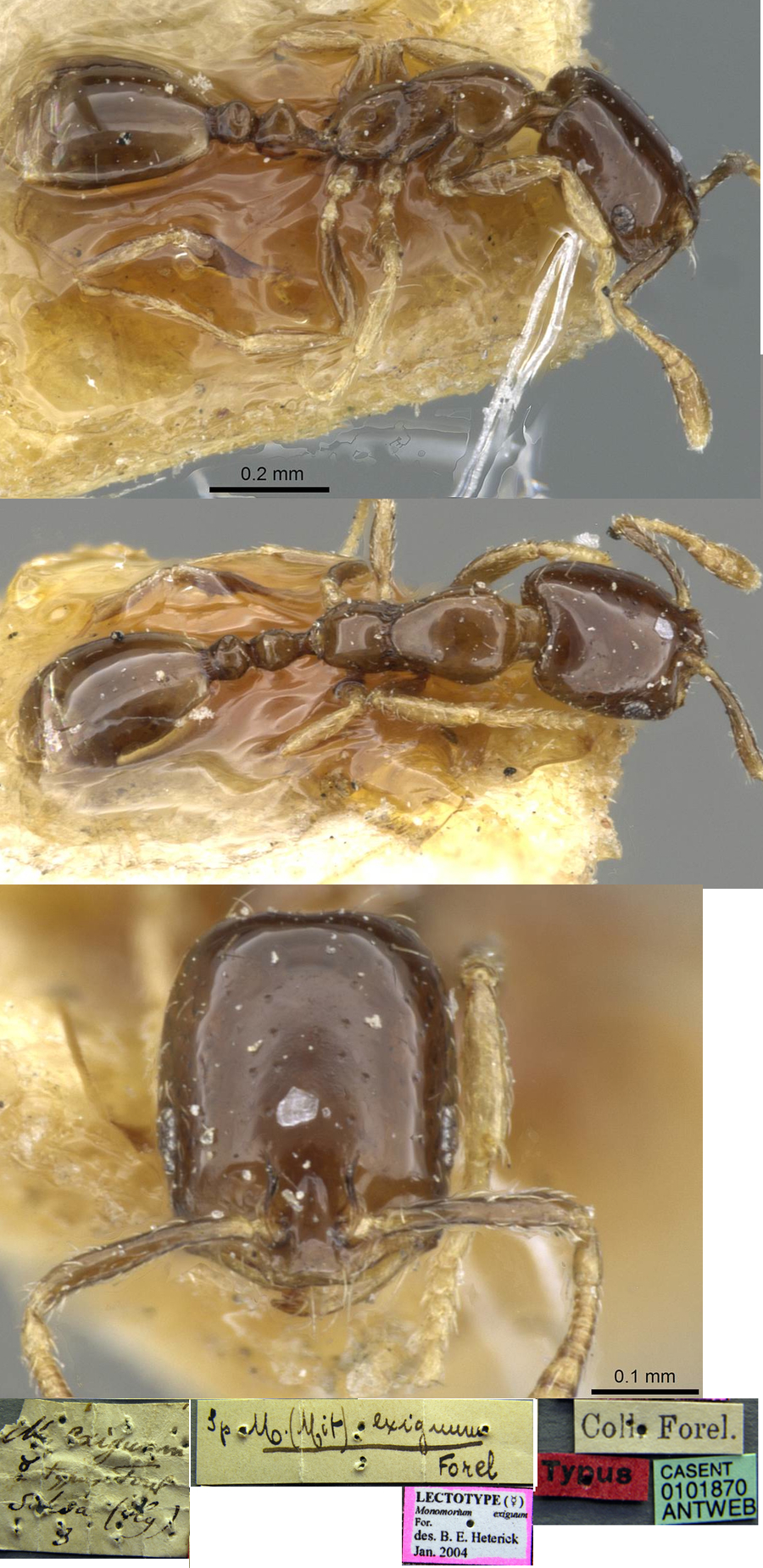 The
photomontage is of the type worker collated
from http://www.antweb.org/specimen.do?name=casent0101870 The
photomontage is of the type worker collated
from http://www.antweb.org/specimen.do?name=casent0101870
|
Heterick (2006) [Heterick terminology, here rejected;
notably the misuse of setae for hairs, and shorter decumbent
setae/setulae (?) for pubescence]
WORKER DESCRIPTION
HEAD: Head rectangular, vertex planar or weakly concave;
frons shining and smooth except for piliferous pits; pilosity of frons
a mixture of well-spaced, distinctly longer erect and semi-erect hairs
[setae] interspersed with pubescence [shorter decumbent setae or
setulae]. Eye moderate, eye width 1–1.5× greatest width of antennal
scape; (in full-face view) eyes set below midpoint of head capsule;
(viewed in profile) eyes set around midline of head capsule; eye
elliptical, curvature of inner eye margin may be more pronounced than
that of its outer margin. Antennal segments 11; antennal club
three-segmented. Clypeal carinae weakly to strongly defined;
anteromedian clypeal margin straight; paraclypeal hairs moderately long
and fine, curved; posteromedian clypeal margin approximately level with
antennal fossae. Anterior tentorial pits situated nearer antennal
fossae than mandibular insertions. Frontal lobes straight, parallel.
Psammophore absent. Palp formula 2,2. Mandibular teeth three, plus
minute, basal denticle or angle; mandibles with sub-parallel inner and
outer margins, smooth (except for piliferous pits); masticatory margin
of mandibles approximately vertical or weakly oblique; basal tooth a
small to minute denticle or angle, much smaller than t3 (four teeth
present).
ALITRUNK [MESOSOMA]: Promesonotum shining and mainly
smooth, vestigial striolae, if present, confined to lower anterior
mesopleuron; (viewed in profile) anterior promesonotum smoothly
rounded, thereafter more-or-less flattened; promesonotum on same plane
as propodeum, promesonotal hairs seven to twelve; standing promesonotal
hairs a mixture of well-spaced, distinctly longer, erect and semi-erect
hairs which are curved distally and often paired, interspersed
decumbent pubescence; appressed promesonotal ?? [setulae] few, mainly
on sides of promesonotum. Metanotal groove strongly impressed, with
distinct transverse costulae, or, metanotal groove vestigial. Propodeum
shining and smooth, with a few weak striolae on metapleuron; propodeal
dorsum convex; propodeum always smoothly rounded; erect propodeal hairs
consisting of one prominent pair anteriad, with other shorter hairs
very sparse or absent; appressed propodeal pubescence very sparse or
absent; propodeal spiracle equidistant from metanotal groove and
declivitous face of propodeum. Vestibule of propodeal spiracle absent
or not visible. Propodeal lobes present as vestigial flanges or small
strips of cuticle only.
PETIOLE AND POSTPETIOLE: Petiolar spiracle lateral and
situated within anterior sector of petiolar node; node (viewed in
profile) conical, vertex tapered; appearance of node shining and smooth
throughout; ratio of greatest node breadth (viewed from front) to
greatest node width (viewed in profile) about 1:1; anteroventral
petiolar process absent or vestigial; ventral petiolar lobe present;
height ratio of petiole to postpetiole between 3:2 and 4:3;
height–length ratio of postpetiole about 1:1; postpetiole shining and
smooth; postpetiolar sternite without anterior lip or carina, or this
structure vestigial.
GASTER: Pilosity of first gastral tergite consisting of
well-spaced, erect and semi-erect hairs interspersed with sparse
appressed pubescence.
GENERAL CHARACTERS: Color variable, pale yellow to
brown. Worker caste monomorphic
LECTOTYPE WORKER MEASUREMENTS
(M. exiguum): HML 0.93 HL 0.36
HW
0.28 CeI 78 SL 0.22 SI 79 PW 0.18
(M. exiguum bulawayense): HML
1.00
HL 0.39 HW 0.32 CeI 81 SL 0.26 SI 83 PW 0.20
(M. faurei): HML 0.88 HL 0.35
HW
0.29 CeI 83 SL 0.22 SI 76 PW 0.18
(M.
exiguum flavescens): HML 0.89 HL 0.36 HW 0.30 CeI 82 SL 0.22 SI
75 PW 0.18
(M.
minutissimum): No measurements taken as lectotype is headless.
Non-types: HML 0.79–0.97; HL 0.33–0.39 HW
0.26–0.29 CeI 73–81 SL 0.22–0.26 SI 81–93 PW 0.16–0.20 (n=20).
|
Separation of populations (in part from statements in
Heterick, 2006). In his key to separate Malagasy Monomorium, Heterick had "Antennae
11-segmented; metanotal groove weakly impressed; in profile, propodeum
rather elongate and petiolar node always conical, its dorsum tapered
(depigmented yellow to brown)".
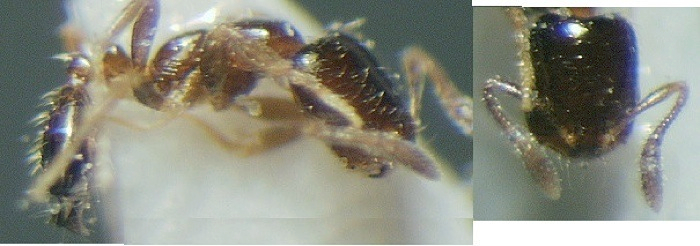 dark longer-headed specimens; designated as the type
form by Heterick (2006: 116), as described by Forel (1894b: 85) dark longer-headed specimens; designated as the type
form by Heterick (2006: 116), as described by Forel (1894b: 85)
|
type form (lectotype) |
 populations
with dark shorter headed specimens. populations
with dark shorter headed specimens. |
bulawayensis
(lectotype) |
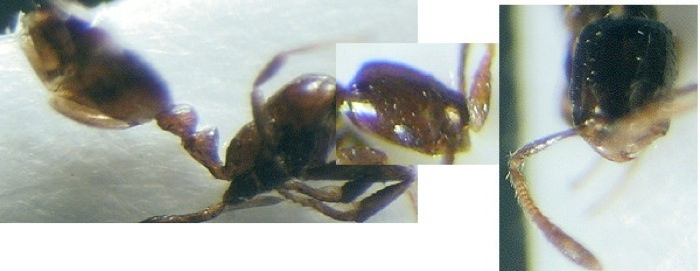 slightly
bicoloured appearance (yellowish-brown
head and gaster; yellowish alitrunk, appendages and base of gaster
(lectotype) slightly
bicoloured appearance (yellowish-brown
head and gaster; yellowish alitrunk, appendages and base of gaster
(lectotype) |
faurei (lectotype) |
| apparently similar to faurei but
(perhaps) with more deeply incised metanotal groove |
minutissimum
(paralectotype) |
 populations with relatively pale workers with a
strongly constricted alitrunk (mesosoma). populations with relatively pale workers with a
strongly constricted alitrunk (mesosoma). |
flavescens (lectotype) |
|
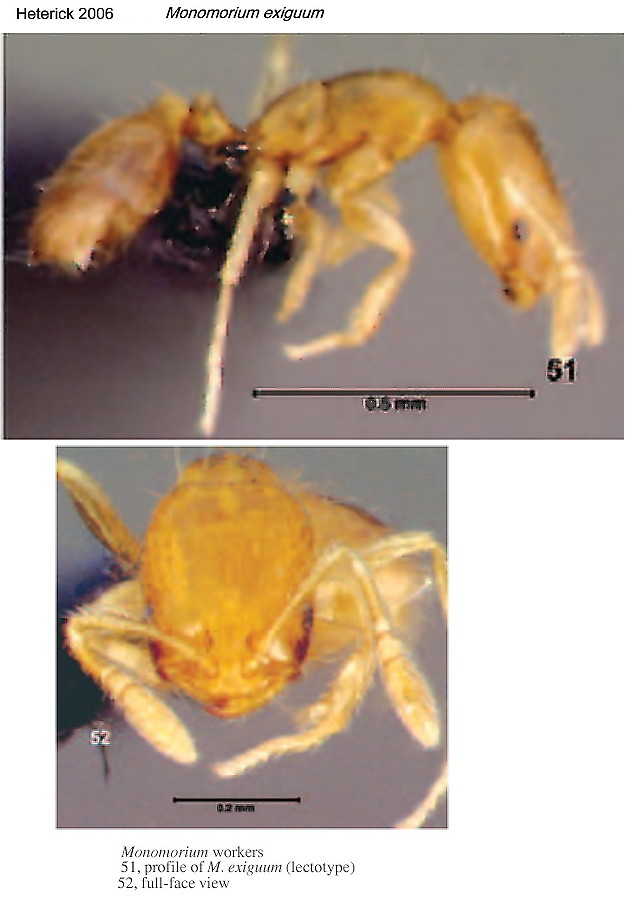 Monomorium
exiguum sensu stricto (Heterick,
2006, designated lectotype from original collection). The photograph
from Heterick's paper is much paler than Heterick's description. the
specimen below from Gabon shows the dark colour, as does the true type
worker (above). Monomorium
exiguum sensu stricto (Heterick,
2006, designated lectotype from original collection). The photograph
from Heterick's paper is much paler than Heterick's description. the
specimen below from Gabon shows the dark colour, as does the true type
worker (above).
|
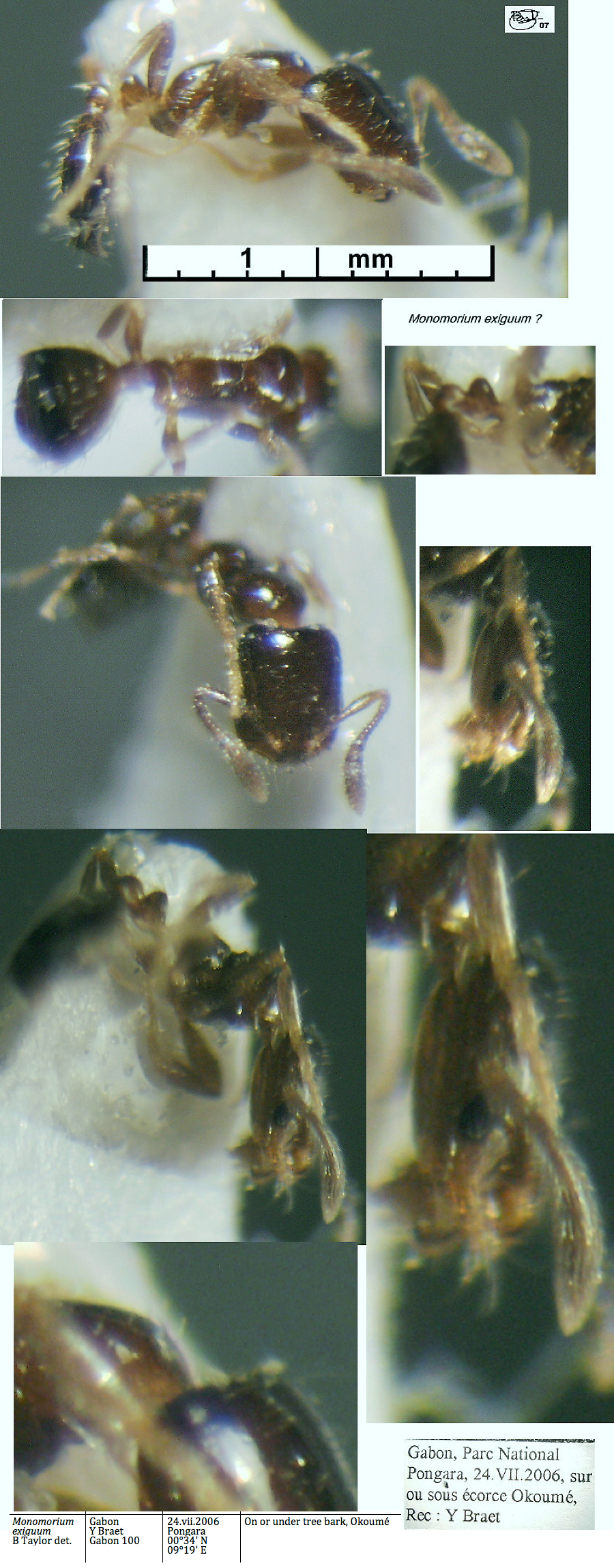 The
photomontage is of a worker from Gabon, Pongara National
Park; collector
Yves Braet (Gabon 100; also Gabon 95) The
photomontage is of a worker from Gabon, Pongara National
Park; collector
Yves Braet (Gabon 100; also Gabon 95)
|
 Monomorium
exiguum bulawayense lectotype designated by Heterick (2006) as
populations with relatively pale workers with a strongly constricted
alitrunk (mesosoma). The photomontage of the bulawayensis type
from Zimbabwe is collated from http://www.antweb.org/specimen.do?name=casent0010763 Monomorium
exiguum bulawayense lectotype designated by Heterick (2006) as
populations with relatively pale workers with a strongly constricted
alitrunk (mesosoma). The photomontage of the bulawayensis type
from Zimbabwe is collated from http://www.antweb.org/specimen.do?name=casent0010763
|
 The
photomontage is of a dark brown worker from Ghana, collecteor S
Sky Stephens, 2006 (06G--87); this appears to be close to the bulawayensis
form. The
photomontage is of a dark brown worker from Ghana, collecteor S
Sky Stephens, 2006 (06G--87); this appears to be close to the bulawayensis
form.
|
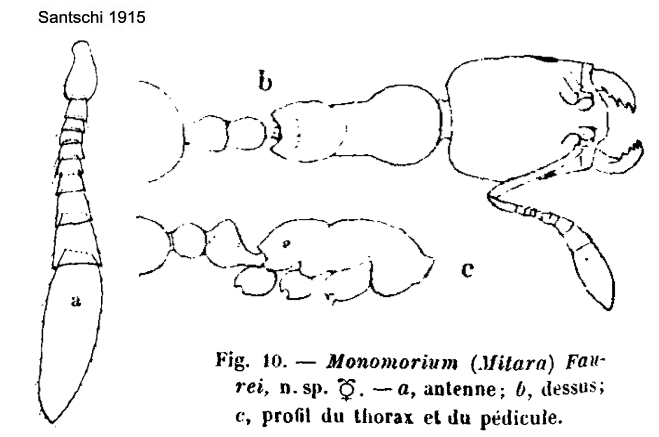 Monomorium exiguum faurei
lectotype designated by Heterick (2006) as having populations with a
slightly bicoloured appearance (yellowish-brown head and gaster;
yellowish alitrunk, appendages and base of gaster (lectotype). Monomorium exiguum faurei
lectotype designated by Heterick (2006) as having populations with a
slightly bicoloured appearance (yellowish-brown head and gaster;
yellowish alitrunk, appendages and base of gaster (lectotype).
Santschi's (1915c) description of faurei is -
WORKER - TL 1.3-1.5; Head a quarter longer than wide; sides slightly
arcuate, posterior border feebly convex. Mandibles with 4 teeth, the
inner teeth somewhat reduced. Clypeus with indistinct carinae. Eyes in
anterior third of sides. Scapes reaching the posterior fifth of head;
segment 1 of the funiculus as long as wide; segments 4-8 a quarter to
half slimmer than long; apex of club as long as preceding eight
segments together. Propodeum a little less convex than in orientale
(from India) but more convex than clavicorne variety punicum
(from Tunisia). Pedicel nodes equally wide; petiole a good third higher
than postpetiole.
Colour deep yellow; head, two areas on each side of first gastral
segment and following segments, brown yellow, except on the posterior
borders. Smooth and shiny. Pilosity sparse; antennae pubescent.
Several workers from Gabon, by F. Faure; others from Guinea,
at Mamou, by Silvestre (originally noted in Santschi, 1914d) as atomus
stirps mictilis Forel; now regarded as sp. mictile from
Ethiopia and Sudan).
See http://www.antweb.org/specimenImages.do?name=casent0010878
|
 The
photomontage is of a worker from Ghana, collector S Sky
Stephens (06G0032); this shows the bicoloured pattern, including the
pale
base to the gaster. The
photomontage is of a worker from Ghana, collector S Sky
Stephens (06G0032); this shows the bicoloured pattern, including the
pale
base to the gaster.
|
 The
photomontage is derived from that shown on http://sifolinia.blogspot.com/2007/11/monomorium-exiguum.html,
taken by Mike Lush, Gambia, 3.iv.2007. The
photomontage is derived from that shown on http://sifolinia.blogspot.com/2007/11/monomorium-exiguum.html,
taken by Mike Lush, Gambia, 3.iv.2007.
|
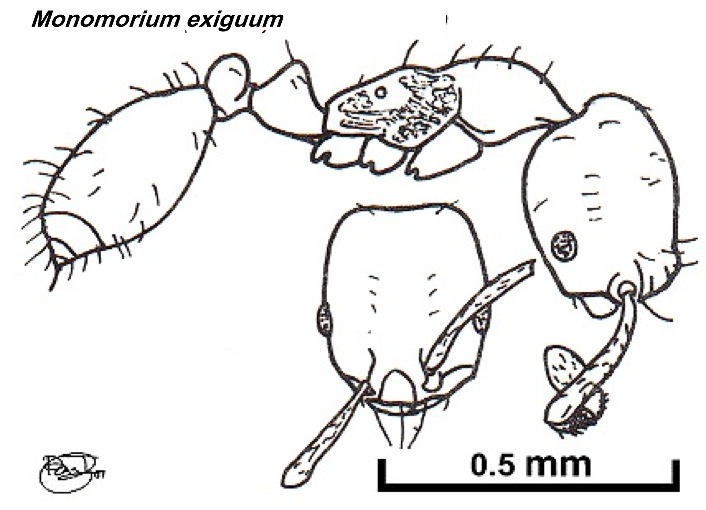 Nigerian
specimen - probably also faurei (Taylor, 1980a: 33) TL
1.63 mm, HL 0.40, HW 0.34, SL 0.31, PW 0.23 (in my Guide as Monomorium
species T²). Others TL 1.5-1.7 mm (Bolton, 1987: 388,
not illustrated). Nigerian
specimen - probably also faurei (Taylor, 1980a: 33) TL
1.63 mm, HL 0.40, HW 0.34, SL 0.31, PW 0.23 (in my Guide as Monomorium
species T²). Others TL 1.5-1.7 mm (Bolton, 1987: 388,
not illustrated).
Colour yellow, head and gaster more brown. Eleven-segmented antennae.
Cuticle of head translucent. Lateral mesonotum and propodeum very
finely rugoreticulate. Erect hairs moderately long but relatively
sparse. Otherwise as key.
In Nigeria, from CRIN (B. Bolton; B. Taylor). I
collected it from a leaf on a low shrub under forest shade.
|
 The photomontage is of a worker from Cameroun;
Nko'ondo; aphid surevy; collector A Fotso Kuate (fk sp 61). The photomontage is of a worker from Cameroun;
Nko'ondo; aphid surevy; collector A Fotso Kuate (fk sp 61).
Matches the Nigeria specimen I drew in size and
morphology.
|
 Monomorium
exiguum minutissimum
paralectotype designated by Heterick (2006) as populations similar to faurei
but (perhaps) with more deeply incised metanotal groove. Monomorium
exiguum minutissimum
paralectotype designated by Heterick (2006) as populations similar to faurei
but (perhaps) with more deeply incised metanotal groove.
|
 The photomontage
is of a specimen apparently matching
Santschi's minutissimum description and illustration, from Gabon,
Pongara National Park; collector Yves Braet (Gabon 114); e.g the head
shape in full face
view and the lateral short low petiole. The photomontage
is of a specimen apparently matching
Santschi's minutissimum description and illustration, from Gabon,
Pongara National Park; collector Yves Braet (Gabon 114); e.g the head
shape in full face
view and the lateral short low petiole.
|
 Queen Queen
The photomontage is of what seems likely to be a queen from Liberia,
Liabala; collector E Poiriet (Liabal SLAM 4).
|
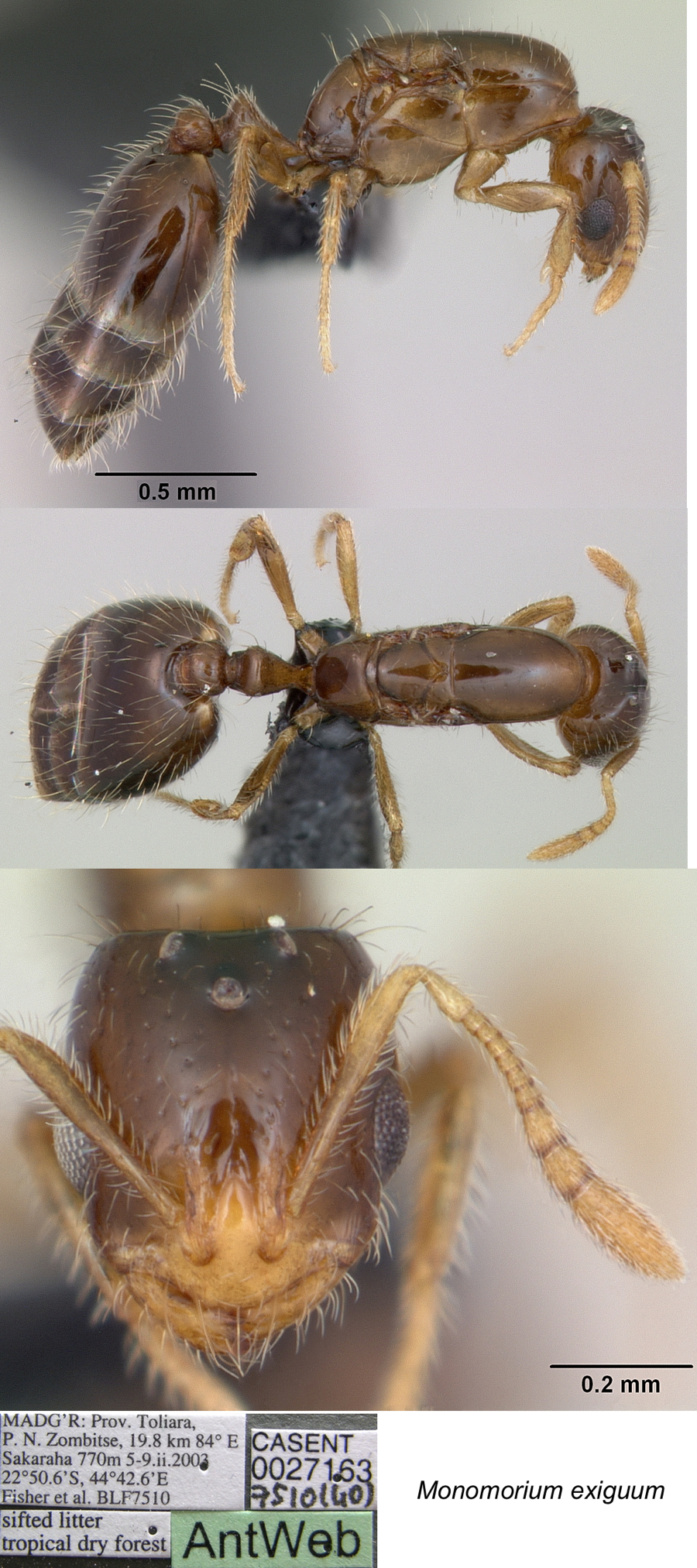 Monomorium
exiguum queen. Monomorium
exiguum queen.
The photomontage of a queen from Madagascar is collated from http://www.antweb.org/specimen.do?name=casent0027163
|
 Male Male
The photomontage is of what seems likely to be a male from Gabon,
Pongara National Park; collector Yves Braet (Gabon 237).
|
|